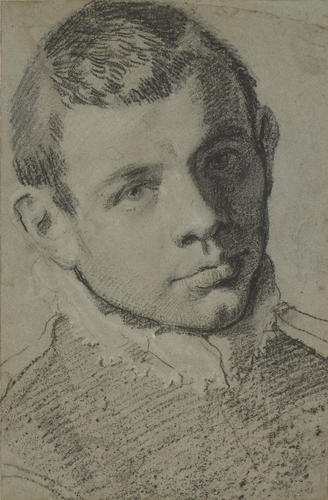-
1 of 253523 objects
A presumed self-portrait c. 1575-80
Black and white chalks on blue-grey paper | 38.0 x 25.0 cm (sheet of paper) | RCIN 902254

Attributed to Annibale Carracci (Bologna 1560-Rome 1609)
A self-portrait (?) c. 1575-80
-
A portrait drawing, probably of Annibale Carracci. He is shown facing three-quarters to the right, his head tilted to the left, looking out towards the viewer.
In the late sixteenth century the brothers Annibale and Agostino Carracci and their cousin Ludovico established in Bologna an informal academy that insisted on drawing from life as the foundation of artistic practice – a seemingly simple sentiment, but one that transformed the art world in the city and ultimately throughout Italy. Many of the Carracci's early painted works were collaborations that required a harmonisation of their styles, and thus the attribution of their early works remains contentious. Both the authorship of this drawing and the identity of the sitter have been disputed, and its status as a self-portrait by Annibale is therefore only provisional: several scholars in recent years have strenuously upheld an attribution to Annibale but denied it as a self-portrait; others have just as vehemently assigned the drawing to Ludovico, on occasion claiming it as his self-portrait.
A number of other works seem to confirm that this drawing depicts Annibale. A small painted portrait in Parma – bearded, with a hat, and dated 17 April 1593 – plainly depicts the same sitter, with a broad face, a wide and fleshy nose with open nostrils, full lips and a prominent chin; what was probably that painting was described in Malvasia’s early biography of the artist as a self-portrait of Annibale. The painted portrait of Annibale in the Vasari Corridor of the Uffizi (cf. RCIN 421120–421343), which was inventoried as a self-portrait in 1675, plausibly depicts the same sitter later in life; the identity of that painting as a portrait of Annibale is confirmed by the artist’s Self-Portrait on an Easel in the Hermitage (see RCIN 901984). Finally, a late, rapid drawing in the Getty shows Annibale prematurely aged and careworn, with sunken cheeks and hunched posture, but still with the same boyish cropped hair seen here.
It is, however, less certain that the present drawing is by Annibale. The pose is unusual for a self-portrait, with the head both tilted and shown at an angle. The clear transitions between areas of dark and light are typical of several early drawings usually attributed to Ludovico, but the truth is that there are few drawings from the early years of the Carracci for which the authorship (or date) is certain. The bold, even rough treatment overall is equally typical of drawings usually given to Annibale, and an attribution to him is retained here.
It is remarkably difficult to gauge the age of sitters in historical portraits, for conventions of dress, hairstyle and, indeed, of portraiture itself can make sitters appear significantly older or younger than a modern subject of the same age; nonetheless, the sitter here cannot be more than twenty years old and may be several years younger. If this is indeed a portrait of Annibale (or of Ludovico or Agostino, for that matter), it would be among the earliest surviving drawings by any of the Carracci. That is not in itself improbable, as an artist would be more likely to preserve a self-portrait, or a portrait of a member of his family, than he would some other study: Albrecht Dürer’s self-portrait drawing at the age of 13 survives in Vienna, and in the British Museum is a drawing that is probably a self-portrait of Raphael in his mid-teens.
Text adapted from Portrait of the Artist, London, 2016Provenance
Probably acquired by George III in 1762 as part of the collection of Cardinal Alessandro Albani; first recorded in a Royal Collection inventory of c. 1800-1820
-
Creator(s)
Acquirer(s)
-
Medium and techniques
Black and white chalks on blue-grey paper
Measurements
38.0 x 25.0 cm (sheet of paper)
Object type(s)
Other number(s)
RL 2254Alternative title(s)
A self-portrait (?)
Self-portrait